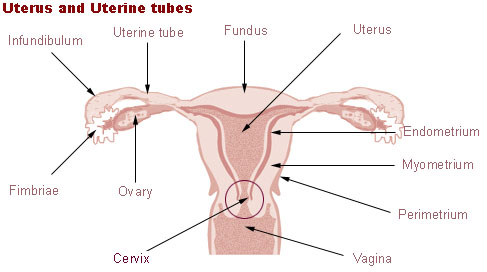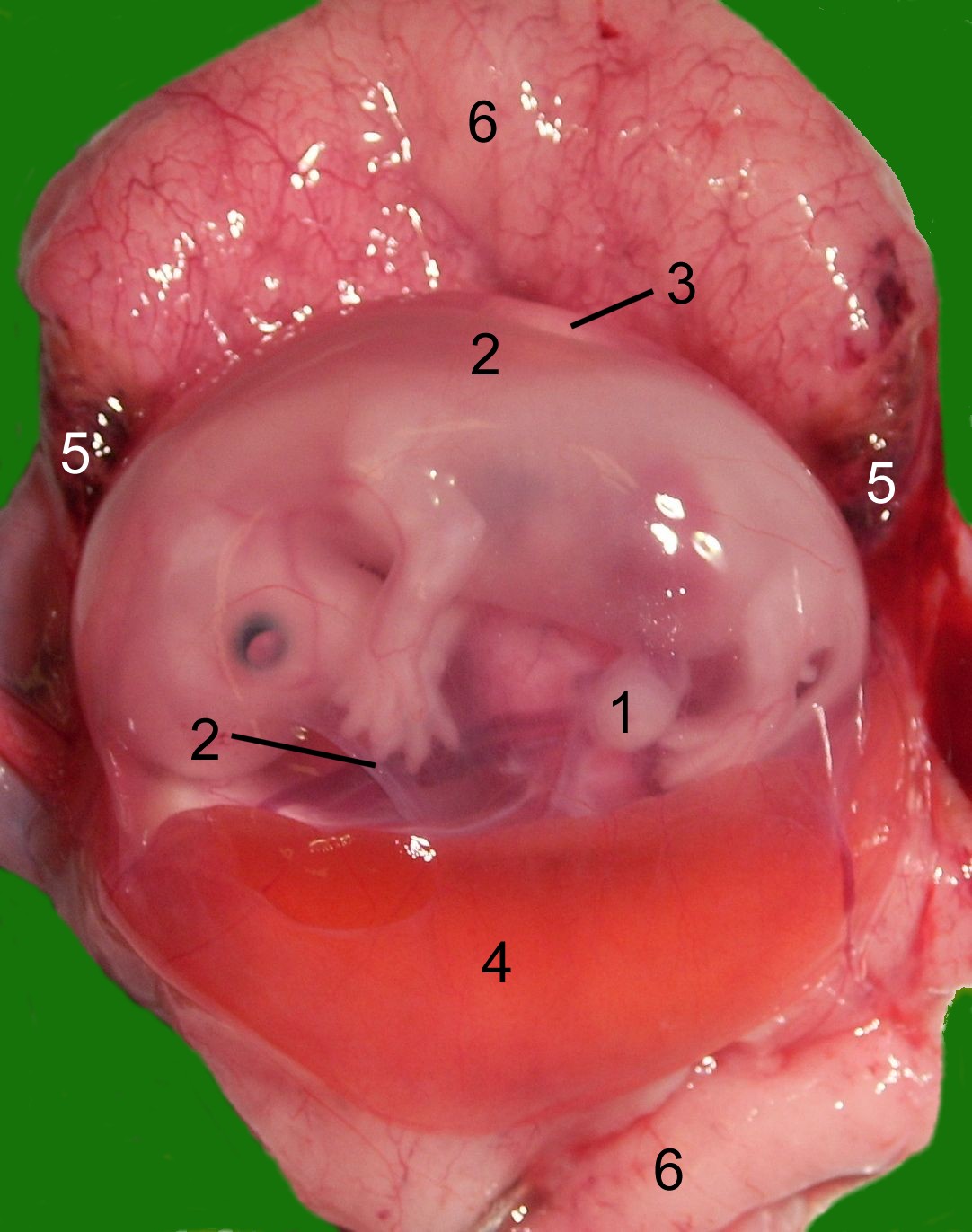- Endometrium
Infobox Anatomy
Name = Endometrium
Latin = tunica mucosa uteri
GraySubject = 268
GrayPage = 1262

Caption = Uterus and uterine tubes. (Endometrium labeled at center right.)

Caption2 = Opened uterus withcat fetus in midgestation: 1umbilicus , 2amnion , 3allantois , 4Yolk sac , 5 developing marginalhematoma , 6 maternal part ofplacenta (endometrium)
Precursor =
System =
Artery =
Vein =
Nerve =
Lymph =
MeshName = Endometrium
MeshNumber = A05.360.319.679.490
DorlandsPre = t_22
DorlandsSuf = 12832078
The endometrium is the inner membrane of themammalian uterus .Function
The endometrium functions as a lining for the uterus, preventing adhesions between the opposed walls of the
myometrium , thereby maintaining the patency of the uterine cavity. During themenstrual cycle orestrous cycle , the endometrium grows to a thick, blood vessel-rich, glandular tissue layer. This represents an optimal environment for theimplantation of ablastocyst upon its arrival in the uterus.During
pregnancy , the glands andblood vessel s in the endometrium further increase in size and number. Vascular spaces fuse and become interconnected, forming theplacenta , which suppliesoxygen and nutrition to theembryo andfetus .Cycle
The endometrial lining undergoes cyclic regeneration. Humans and the
great apes display themenstrual cycle , whereas most other mammals are subject to anestrous cycle . In both cases, the endometrium initially proliferates under the influence ofestrogen . However, onceovulation occurs, in addition to estrogen, the ovary will also start to produceprogesterone . This changes the proliferative pattern of the endometrium to a secretory lining. Eventually, the secretory lining provides a hospitable environment for one or more blastocysts.If no blastocyst is detected, the progesterone level drops and the endometrial lining is either reabsorbed (estrous cycle) or shed (menstrual cycle). In the latter case, the process of shedding involves the breaking down of the lining, the tearing of small connective blood vessels, and the loss of the tissue and blood that had constituted it through the
vagina . The entire process occurs over a period of several days. Menstruation may be accompanied by a series of uterine contractions; These help expel the menstrual endometriumIn case of implantation, however, the endometrial lining is neither absorbed nor shed. Instead, it remains as "
decidua ". The decidua becomes part of the placenta; it provides support and protection for the gestation.If there is inadequate stimulation of the lining, due to lack of hormones, the endometrium remains thin and inactive. In humans, this will result in
amenorrhea . Aftermenopause , the lining is often described as being atrophic. In contrast, endometrium that is chronically exposed to estrogens, but not to progesterone, may become hyperplastic.In humans, the cycle of building and shedding the endometrial lining lasts an average of 28 days. The endometrium develops at different rates in different mammals. Its formation is sometimes affected by seasons, climate, stress, and other factors. The endometrium itself produces certain
hormone s at different points along the cycle. This affects other portions of thereproductive system .Histology
The endometrium consists of a single layer of
columnar epithelium , resting on a layer ofconnective tissue , which varies in thickness according tohormonal influences - the "stroma". Simple tubular uterineglands reach from the endometrial surface through to the base of the stroma, which also carries a rich blood supply of spiral arteries. In a woman of reproductive age, two layers of endometrium can be distinguished. These two layers occur only in endometrium lining the cavity of the uterus, not in the lining of the Fallopian tubes: [Blue Histology - Female Reproductive System. School of Anatomy and Human Biology - The University of Western Australia http://www.lab.anhb.uwa.edu.au/mb140/CorePages/FemaleRepro/FemaleRepro.htm Accessed 20061228 20:35]
*The "functional layer" is adjacent to the uterine cavity. This layer is built up after the end of menstruation during the first part of the previousmenstrual cycle . Proliferation is induced byestrogen (follicular phase of menstrual cycle), and later changes in this layer are engendered by progestrone from thecorpus luteum (luteal phase). It is adapted to provide an optimum environment for the implantation and growth of theembryo . This layer is completely shed duringmenstruation .
*The "basal layer", adjacent to themyometrium and below the functional layer, is not shed at any time during the menstrual cycle, and from it the functional layer develops.In the absence of progesterone, the arteries supplying blood to the functional layer constrict, so that cells in that layer becomeischaemic and die, leading tomenstruation .It is possible to identify the phase of the menstrual cycle by observing histological differences at each phase:
Pathological conditions
Adenomyosis is the growth of the endometrium into the muscle layer of the uterus (themyometrium ).Endometriosis is the growth of endometrial tissue outside the uterus.Endometrial cancer is the most commoncancer of the human female genital tract.Asherman's syndrome , also known as intrauterineadhesions occurs when the basal layer of the endometrium is damaged by instrumention (eg.D&C ) or infection (eg. endometrialtuberculosis ) resulting in endometrial sclerosis and adhesion formation partially or completely obliterating the uterine cavity.ee also
*
Menstrual cycle
*Estrous cycle
=AdditionalReferences
External links
* - "The uterus, uterine tubes and ovary with associated structures."
* - "Female Reproductive System uterus, endometrium"
*
*
* [http://medlib.med.utah.edu/WebPath/FEMHTML/FEM017.html Histology at utah.edu. Slide is proliferative phase - click forward to see secretory phase]
* [http://www.ashermans.org/ Ashermans.org]
Wikimedia Foundation. 2010.
